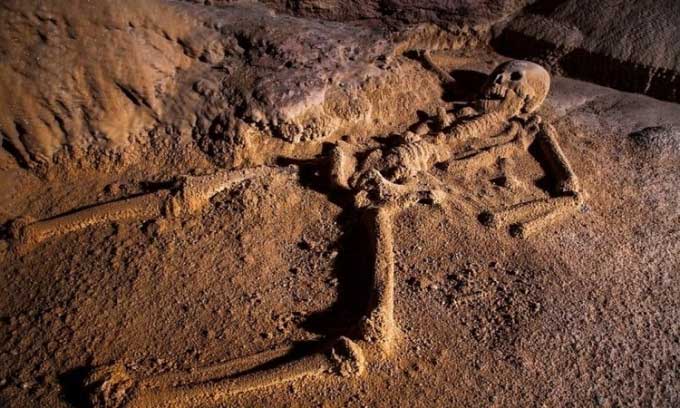The skeleton of a teenage Maya covered in crystal after being placed in an underground cave for sacrifice by the Maya.
The Maya believed that caves, especially those that extend several kilometers underground, were gateways to the underworld or Xibalba, “the land of fear”, where evil spirits reside. They were deeply afraid of the underworld and felt the need to appease the gods living there by performing human sacrifices. One such cave where the Maya conducted this terrifying ritual is located in central Belize, near San Ignacio, within the Tapir Mountain Nature Reserve.

The skeleton of the teenage individual known as Crystal Maiden. (Photo: Amusing Planet).
Actun Tunichil Muknal Cave, commonly referred to as “ATM”, was first discovered in the late 1980s. The cave entrance is shaped like a funnel and is submerged in water. The remains of sacrificial offerings can be found right at the mouth of the cave, starting with snail shells and increasing in number as one ventures deeper inside. About 400 meters from the cave entrance is the main area containing the remains of 14 individuals, including the crystal-covered skeleton known as Crystal Maiden.
The skeleton was initially thought to belong to a woman in her twenties, lying on her back with her mouth agape, and her entire skeleton covered in sparkling calcite crystals, leading researchers to name the deceased “Crystal Maiden.” However, further examinations revealed that the skeleton actually belonged to a 17-year-old teenager who had been sacrificed by an ancient Maya priest over 1,000 years ago.
This skeleton is particularly notable for its resting position and two broken ribs. The research team suggests that the individual may have died a violent death before being thrown onto the ground, where it has remained for at least the past 1,100 years. In fact, the skeleton has been preserved to the point of complete calcification.
Other skeletons are located in niches or scattered throughout open spaces, ranging from the remains of a one-year-old child to adults in their 30s and 40s. Throughout the cave, there are numerous pottery vessels, instruments, jewelry, figurines, and stingray bones. Many artifacts have also become calcified on the cave floor. The Maya even carved the cave to create altars for sacrifices, featuring faces, animals, or shadows.
Recent studies on ancient climate in the Central South American region suggest that drought may have played a significant role in the collapse of this civilization. It is likely that this purpose drove the increase in sacrificial activities toward the end of the 9th century, just before the collapse of the Maya empire. Most of the artifacts discovered in Actun Tunichil Muknal remain in their original condition, making this one of the most well-preserved caves containing Maya sacrificial offerings.


















































